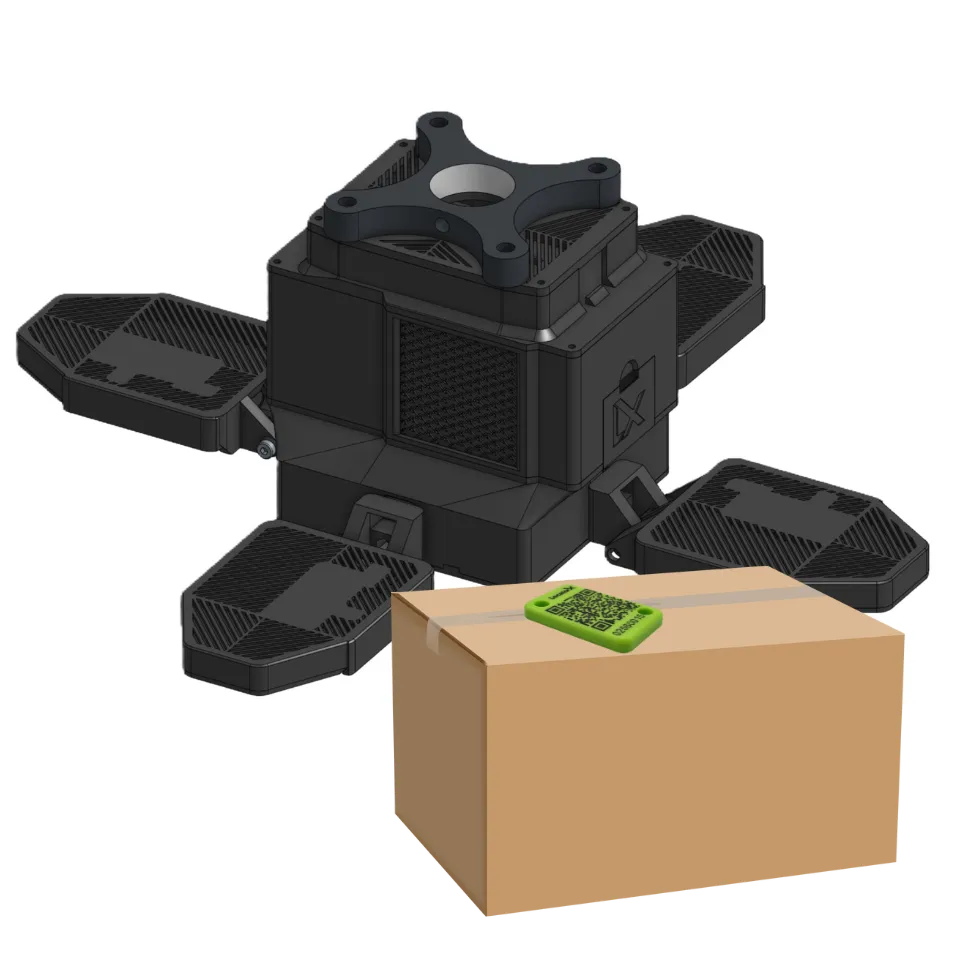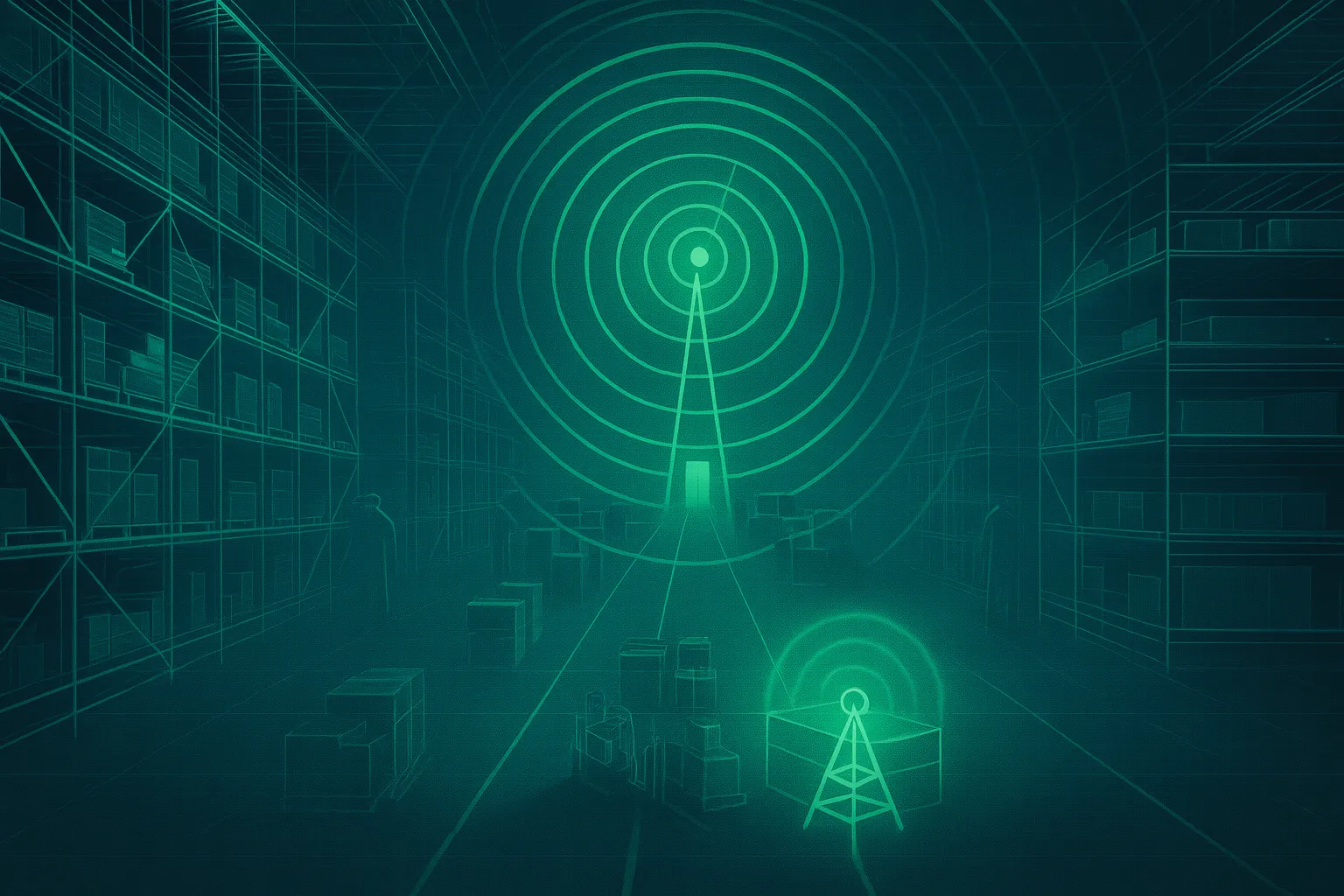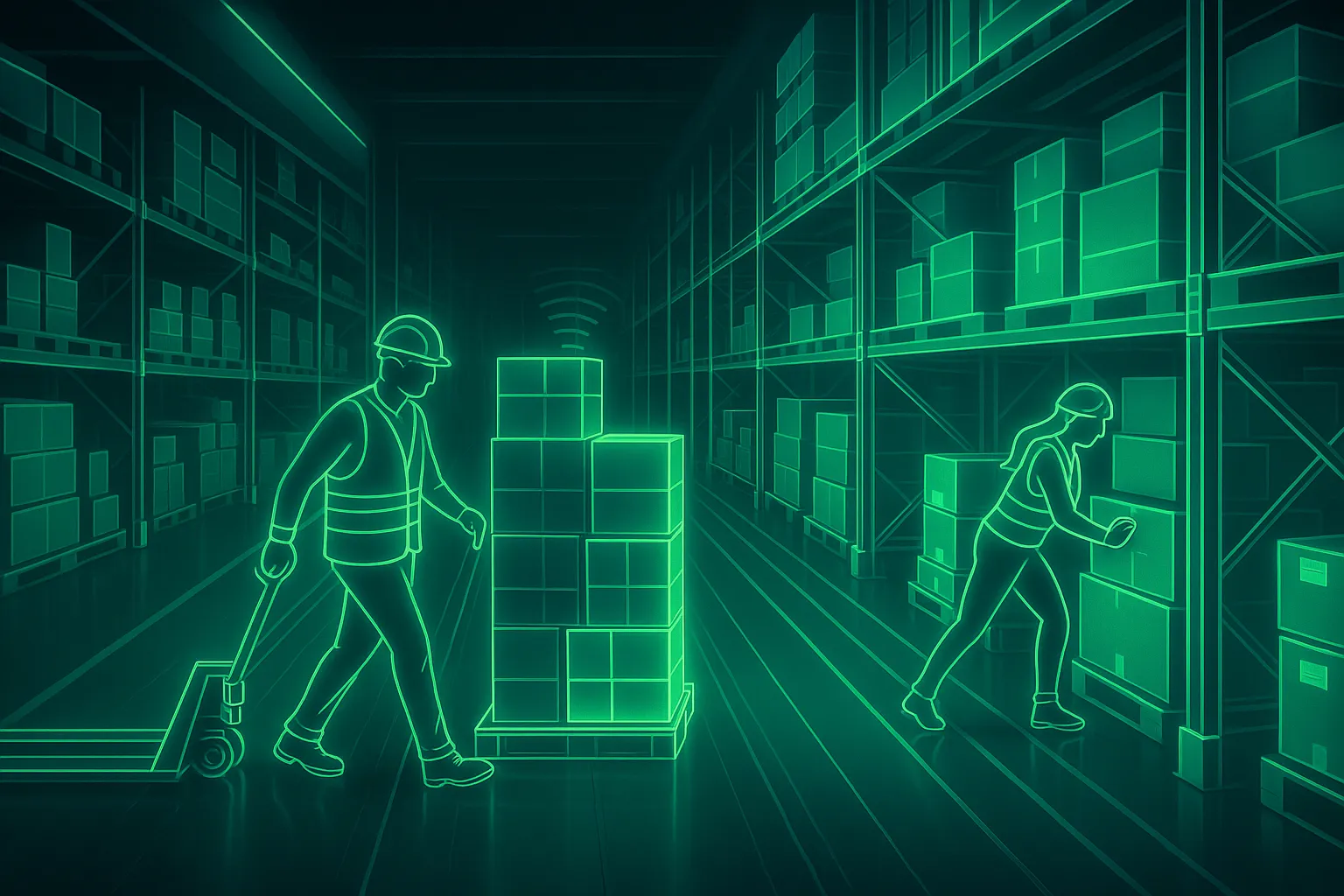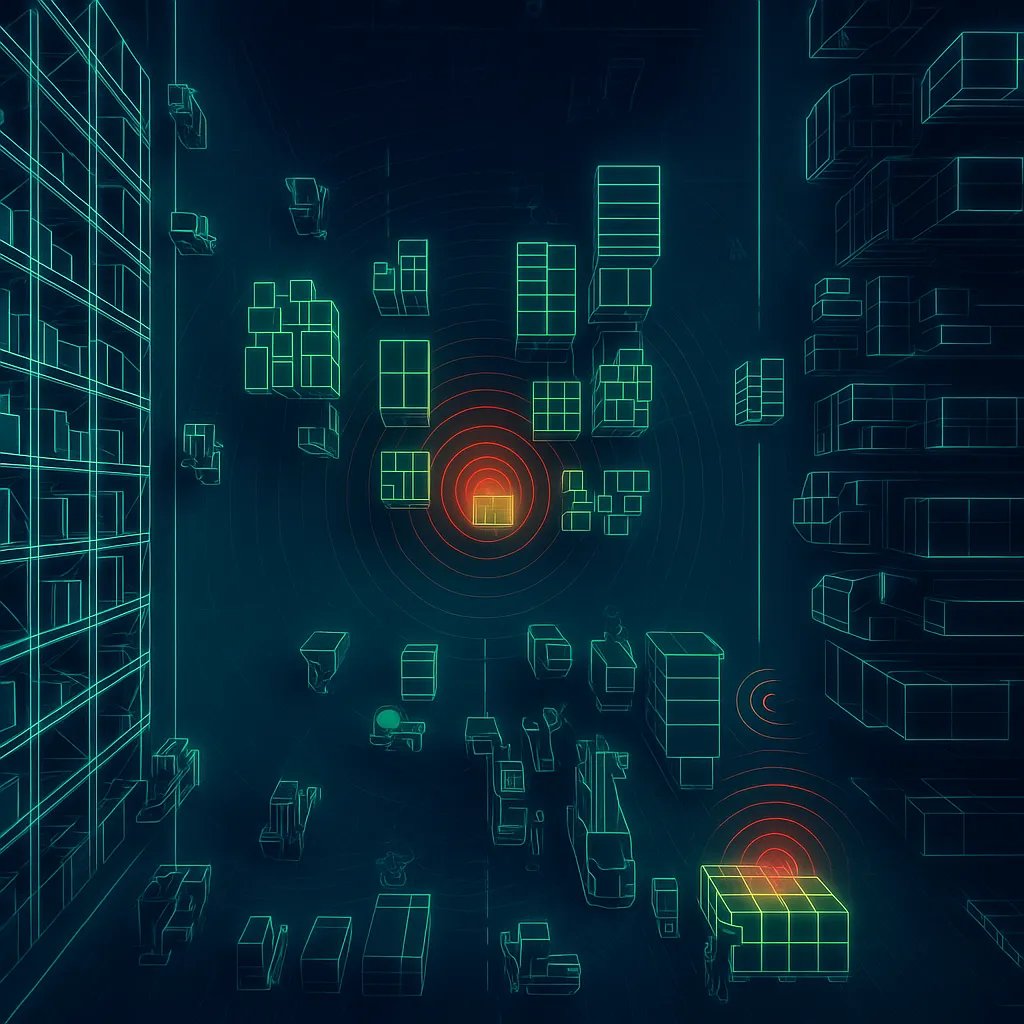
LocatorX BLE Tech Specs
Our BLE sensor, LX Atlas Tag, and corresponding LX Echo were developed with flexibility, scalability and security top of mind for defense operations.
- TAA-Compliant sensors
- Compact design: 28mm wide x 45mm length x 6mm width
- Temperature range: -30 to +80 degrees C
- Dust-tight, water resistant
- Antenna: Embedded PCB Trace
- Accuracy: Zone level to 4 meters
- Supports OTA (Over the Air) firmware upgrades
- Battery life: Up to 5 years (varies based on reporting frequency)
- Weight: 0.3 oz
- Certifications: FCC and UL
- Radio Frequency: Bluetooth Low Energy (BLE) with mesh capabilities
Why Is the LocatorX BLE Solution Different?
.webp)
The LX Atlas Tag
The LX Atlas Tag is the foundation of our tracking ecosystem. It is the tiny, intelligent sensor that brings physical assets to life in the digital world. Designed for years-long battery life and effortless deployment, each LX Atlas Tag continuously reports its status and movement so you always know where things are and how they are behaving. From individual items to large-scale inventory, LX Atlas Tags deliver dependable visibility even at massive scale. They wake when motion is detected, transmit securely, and then return to ultra-low-power sleep, working quietly in the background so your operation runs smoothly in the foreground.
.webp)
The LX Echo Gateway
The LX Echo Gateway is the anchor of our tracking network—the intelligent receiver that connects every LX Atlas Tag and LX Super Tag to the cloud. Installed throughout your facility, LX Echo Gateways listen, interpret, and forward location and event data in real-time, creating a living digital map of your operation. Each Echo Gateway is designed for reliability at scale. Whether it’s monitoring thousands of assets across a warehouse or covering a large outdoor yard, the Echo ensures that every signal, no matter how faint or distant, finds its way to the system.

The LX Super Tag
The LX Super Tag is the intelligent bridge that keeps every part of our tracking ecosystem connected, even in the toughest environments. Working seamlessly with our LX Atlas Tags and LX Echo Gateways, the LX Super Tag ensures that location and status data keep flowing reliably across your operation, no matter how crowded or complex the radio environment may be. Where other solutions struggle in dense warehouse layouts, metallic structures, or areas with heavy wireless congestion, the LX Super Tag quietly adapts. It listens, routes, and relays information so every LX Atlas Tag stays visible and every LX Echo Gateway stays informed. The result is a network that continues performing even where conventional BLE tracking systems fail.

The LX Neural Network
At the heart of our tracking platform lies an intelligent engine that learns from every signal—our Neural Network. It transforms millions of Bluetooth readings collected by LX Atlas Tags, LX Super Tags, and LX Echo Gateways into precise, real-time location intelligence, without the need for expensive infrastructure or manual calibration. By analyzing signal patterns from hundreds of receivers simultaneously, the system pinpoints asset locations with exceptional spatial awareness, even in challenging RF environments. Together, the LX Neural Network and our hardware platform deliver a living, self-learning visibility system—one that doesn’t just show you where things are, but understands how they move, interact, and evolve within your operation.
When BLE Is the Right IoT Asset Tracking Choice
BLE sensors perform well in warehouse environments, manufacturing floors, and facility-based operations where assets need tracking within close range.

When replacing or recharging batteries frequently is not practical, BLE sensors can operate for 2-5 years on a single battery. This makes them ideal for tracking assets in hard-to-reach locations, remote locations or items that may need to be stored long-term.

BLE tags typically cost significantly less than LoRaWAN, GPS, or cellular-enabled trackers, making them practical for tracking large volumes of components, tools, or non-critical assets across defense supply chains.

BLE operates independently of cellular networks, making it suitable for secure facilities where external communication is restricted or monitored. Unexpected movement patterns can also be detected and reported.

BLE enables sophisticated precision zone-based location identification. As assets move through different warehouse zones, the network can trigger automated processes like environmental monitoring adjustments, security protocol changes, or workflow notifications. For sensitive defense materials, this means automatic implementation of appropriate handling protocols based on asset location and classification.

BLE + Mesh Networks: Advancing Warehouse Intelligence
Traditional BLE communication follows a simple star topology, where individual sensors communicate directly with central gateways. However, the introduction of BLE Mesh networking has revolutionized how these systems operate in large-scale environments. BLE Mesh transforms individual sensors into nodes of an intelligent network that can span entire warehouse complexes.
In a BLE Mesh network, each device can act as both a sensor and a communication relay. When a BLE tag needs to send data to a gateway that's beyond its direct range, it can route that information through other mesh-enabled devices in the network. This creates multiple communication paths between any two points in the system.
The mesh network uses a mass communication approach where messages are relayed through multiple nodes simultaneously. Each device in the mesh can receive, process, and retransmit messages, ensuring that data reaches its destination even if individual nodes fail or become temporarily unavailable. This redundancy is critical in defense applications where communication reliability cannot be compromised.
BLE Mesh networks employ sophisticated algorithms to prevent message loops and manage bandwidth efficiently. Messages include time-to-live counters and unique identifiers that prevent endless circulation while ensuring optimal delivery paths. The network continuously learns and adapts, automatically routing around obstacles, interference, or failed nodes.
Benefits of BLE + Mesh Networks
LocatorX provides you with the tools to eliminate blind spots, ensure readiness, protect warfighters, and strengthen national security. With our technology, the supply chain is not just connected--it's fortified.

Extended Range without Infrastructure Investment
Traditional BLE systems require gateways every 30-100 meters, depending on environmental conditions. BLE Mesh networks can extend an effective range to hundreds of meters by using the sensors themselves as communication infrastructure. This dramatically reduces the number of gateways needed to large warehouse operations.

Scalable Architecture
As warehouse operations expand or change layout, BLE Mesh networks adapt automatically. Adding new sensors extends network coverage without requiring infrastructure modifications. This scalability is particularly valuable for defense contractors managing growing inventories or changing facility configurations.

Reduced Single Points of Failure
Traditional star topology networks fail completely when central gateways go offline. BLE Mesh networks distribute communication responsibilities across all nodes, eliminating single points of failure that could compromise entire tracking operations. In mission-critical defense operations, netowrk failures can have serious consequences. BLE Mesh networks automatically detect failed nodes and route communications through alternative paths. This ensures continuous asset visibility even when individual components fail.

Predictive Analytics through Network Data
The mesh network generates rich data about communication patterns, signal strength variations, and node interactions. This information provides insights into warehouse operations that extend beyond basic asset tracking. Defense logistics managers can identify high-traffic areas, optimize storage layouts, and predict maintenance needs based on network performance data.
When Alternative Technologies to BLE May Be Better
For assets that travel beyond facility boundaries, GPS or LoRaWAN solutions provide better coverage. If you're tracking shipments between properties, states, continents, or monitoring vehicles in the field, BLE limitations become apparent.
While ruggedized BLE sensors exist, extremely harsh environments with temperature extremes, high vibration, or electromagnetic interference may require specialized sensor technologies designed for those specific conditions.

Applications requiring second-by-second location updates are better served by active GPS. BLE's intermittent reporting nature isn't suitable for applications demanding constant visibility.
For tracking extremely valuable or sensitive assets requiring real-time tamper detection and immediate alerts, active cellular or satellite-based solutions with real-time monitoring capabilities are more appropriate.
BLE Implementation Considerations
Successful BLE deployment requires understanding both the technology's capabilities and your operational environment. The Internet of Things (IoT) aspect of BLE systems means these sensors become part of a larger connected ecosystem, providing data that integrates with existing warehouse management systems (WMS), enterprise resource planning (ERP), and asset management systems.

Infrastructure Requirements
BLE gateways must be strategically positioned to ensure adequate coverage throughout your facility. Unlike WiFi networks, BLE networks require specific planning for optimal tag detection and data collection.

Data Integration
Consider how BLE sensor data will integrate with exisiting systems. Modern IoT BLE solutions should provide APIs and standard protocols for seamless integration with defense contractor systems and government requirements.

Scalable Planning
Start with pilot programs but ensure your chosen solution can scale to enterprise levels. Defense operations often require tracking thousands to millions of components across multiple facilities.

Security and Compliance
Defense contractors must consider the security implications of any connected technology. Modern BLE sensors incorporate encryption and authentication protocols that meet stringent security requirements. However, proper implementation requires understanding of secure network design and data handling protocols. BLE's short-range nature actually provides secruity advantages in controlled environments. Unlike cellular or satellite systems that transmit data over public networks, BLE creates localized networks that can be completely isolated from external connections when required.
Evaluation Checklist for BLE Sensor Solutions
Technical Requirements
Verify realistic battery life under your specific usage patterns and environmental conditions.

Test actual range in your facility with obstacles, metal shelving, and electromagnetic interference.
Ensure IP rating and temperature ranges meet your operational requirements.
Confirm how many tags each gateway can reliably handle simultaneously.
Evaluate whether the solution supports BLE Mesh networking for enhanced coverage and reliability.
Understand the maximum node density the mesh network can support in your facility size.
Integration Capabilities
APIs for integration with existing enterprise systems.

Ensure data output formats are compatible with your current infrastructure.
Understand data reporting intervals and processing capabilities.
Confirm the system can grow with your operational needs.
Security and Compliance
Verify encryption protocols meet your security requirements.

Understand how devices authenticate and prevent unauthorized access.
Confirm where and how data is stored and processed.
Ensure system provides comprehensive logging for compliance requirements.
Understand where the hardware is manufactured, in the US or TAA-compliant country is important for defense tracking.
Operational Considerations
Evaluate installation requirements and ongoing maintenance needs.

Assess whether management interfaces meet user experience expectations.
Ensure adequate training and ongoing support.
Calculate long-term costs including batteries, maintenance, and system updates. Consider Tracking-As-A-Service models to ensure you have access to the latest sensor technology at all times.
Performance Validation
Conduct pilot testing to verify location accuracy meets operational needs.

Test system performance under normal and stress conditions.
Verify performance in environments with WiFi, cellular, and other RF devices.
Understand system behavior during power outages or network interruptions.
Test network "self-healing" capabilities and performance during node failures.
Verify message routing delays meet your operational timing requirements.
Future-Proofing Your BLE Solution
The BLE standard continues to evolve, with new versions offering improved range, accuracy, and battery life. The introduction of BLE Mesh networking represents one of the most significant advances in the technology, enabling enterprise-scale deployments that were previously impossible with traditional BLE architectures.
When selecting a solution, consider vendors committed to ongoing development and standards compliance. Look for systems that support over-the-air updates and can adapt to changing operational requirements. Mesh-enabled solutions provide particular future-proofing value, as they can scale and adapt to changing facility layouts without requiring infrastructure overhauls.
Modern IoT BLE solutions should integrate with emerging technologies like artificial intelligence and machine learning, enabling predictive maintenance and intelligent asset optimization. These capabilities transform basic tracking into strategic operational intelligence. BLE Mesh networks generate the rich, distributed data sets that advanced analytics systems require for meaningful insights.
The key to successful BLE implementation lies in understanding your specific operational requirements and selecting mesh-enabled solutions designed for the unique challenges of defense contracting. By carefully evaluating technical capabilities, security features, scalability and integration requirements, organizations can implement BLE tracking systems that not only meet current needs but provide a foundation for future warehouse modernization initiatives.
BLE FAQs
Contact UsWhile BLE and Bluetooth use the same protocol, they are not the same. Traditional Bluetooth is used for high bandwidth streaming for such use cases as audio and video. BLE, Bluetooth Low Energy, is used for short-range, wireless broadcasting to send data packets intermittently.
BLE operates in the 2.4 GHz ISM band, the same frequency range as WiFi and classic Bluetooth, but uses a different approach to data transmission.
Technically you can create a constant connection however it was designed to minimize power consumption and "advertise" their presence and data in short bursts, allowing them to remain in sleep mode most of the time.
Since the BLE can be set to transmit at specific intervals or activities, BLE tags can achieve battery life measured in years rather than days.
The History of Bluetooth to BLE: From Connection to Intelligence
Jaap Haartsen, an electrical engineer from The Hague, Netherlands and a member of the National Inventor's Hall of Fame, is the inventor of Bluetooth technology. What began as a simple wireless communication protocol in the late 1990s,designed to replace cables and enable short-range device connections, evolved to become a transformative technology used in everyday applications. Named after King Harald "Bluetooth" Gormsson, who united Danish tribes in the 10th century, Bluetooth technology was created to unite different communication protocols.
The evolution from classic Bluetooth to Bluetooth Low Energy represents a fundamental shift in wireless sensor technology. While traditional Bluetooth focused on continuous data streaming between devices like phones and headsets, BLE was engineered for intermittent data transmission with minimal power consumption. This breakthrough makes BLE sensors ideal for asset tracking applications where devices must operate for months or years on a single battery.


